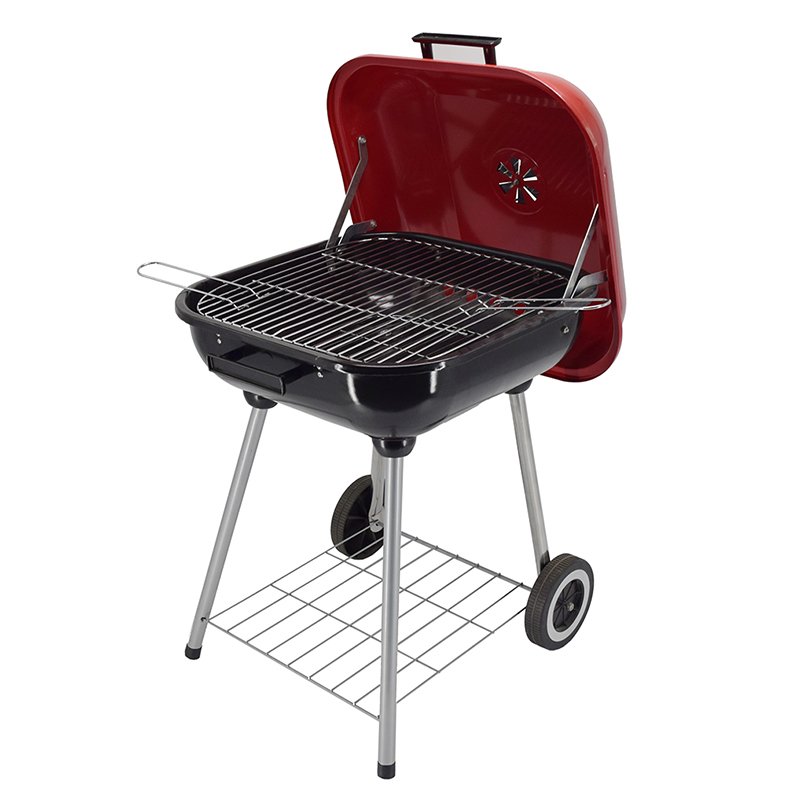world at work: charcoal producing industries in northeastern brazil - 6 burner bbq built in
by:Longzhao BBQ
2020-04-25

A mechanical process that depends on human labor. Since the Bronze Age, the charcoal production process has been known. It was essential for metallurgy until coal was discovered in the early 18 th century to be converted into coke.
Brazil is now the world's largest producer of charcoal over 12 million metric tons last year, largely preserving the charcoal industry because it has a large amount of iron ore and very few coal mines. 3oas_tag. loadAd("Middle1");
The task of employment in Brazil is that the production scale of charcoal is mainly achieved through wood carbonizing in brick kilns, which is a mechanical processing process that is highly dependent on manpower.
We observed the charcoal production process in the northeastern part of the Brazilian state of Bahia and identified the following tasks.
The production of charcoal begins with the fall of trees, usually eucalyptus or pine trees grown in plantations.
After the woodcutter cut the tree with a chain saw, the assistant took the branch and the wood was cut to a certain size and allowed to dry.
The transportation of timber carriers accumulates logs in areas where tractors or trucks can enter.
The tractor and truck assistant load the wood in the cutting area and pile it up in the kiln area.
The assistant travels from the cutting area to the kiln area at the top of the original wooden pile on the loading vehicle.
The worker stays at the top of the pile during loading and unloading (fig 1).
Download figureOpen in the new tabDownload powerpoint figure 1 to unload the tractor trailer in the kiln area.
In each site, hundreds of brick kilns are built on one or more lines for continuous loading and unloading.
The shape of the kiln varies from hemisphere to Dome;
The latter can reach 2.
5 m high, there may be metal beams to support the vertical wall and the horizontal exhaust system.
The kiln has an entrance for loading logs and an outlet on the other side to unload the finished charcoal.
To start filling the kiln, the charcoal outlet is sealed with bricks and applied with clay.
The interior space is filled from the wall to the center of the kiln and from the charcoal outlet to the log entrance.
The density and location of wood in the kiln are the determining factors of charcoal productivity.
When the kiln is full, the entrance is sealed and a worker climbs up to the top of the kiln to start a fire.
The burning process takes 7 days.
The duration of combustion depends on the size of the kiln and the density and freshness of the wood (fig 2).
A worker called a burner checks the color and quantity of smoke, indicating the stage of combustion.
Burner or mud-
When the pyrolysis process, the worker gradually fills the opening with clay to ensure that the heat inside the kiln is suitable for the production of charcoal (fig 3).
Too strong a fire will collapse the stake and tear down the kiln.
The work of the burner requires less physical strength than the kiln worker, but he works around --the-
Supervise several kilns.
Burning tasks are usually done by older workers, former kiln workers, known for their knowledge and able to adapt to special work shifts.
During the burn, download figureOpen in figure 2 of the new tabDownload powerpoint.
Download the new tabDownload figureOpen powerpointFigure 3 u2003 Climbing kiln to get the fire.
After the pyrolysis is completed, the kiln workers manually remove the charcoal using a trolley, metal basket, shovel or Pitchfork and pile it nearby.
In performing this task, workers are usually exposed to smoke and covered with charcoal dust (fig 4).
When this work is carried out, the internal temperature of the kiln may still be high, because of the stuffy burning block, and the sudden contact with oxygen during the opening of the kiln may restart the fire.
Kiln workers work alone or in pairs, loading and unloading kiln alternately.
When they work alone in a large cylindrical kiln, they do one of these tasks in a day.
Download figureOpen in the new tabDownload powerpoint Figure 4 and remove the charcoal from the kiln.
The transportation of charcoal is carried from the scene to the foundry by truck, where it is used to make pigsiron.
Only a few charcoal sites are equipped with silos that allow direct truck loading.
More commonly, charcoal.
The carrier fills the plastic buckets or wicker baskets with charcoal, puts them on the shoulder or head, and climbs the ladder to empty the container onto the truck (fig 5).
Download figureOpen in figure 5 of the new tabDownload powerpoint to load the charcoal truck.
The production sites we visited were scattered in the woods, each with 5-50 workers.
These locations are usually far away from towns and may be difficult to access due to bad road conditions, especially during the rainy season.
Many workers share common dormitories located around the company and work on site for 12 consecutive days and return home once or twice a month after receiving their salary.
Workers in the logging area are sometimes transported by truck or tractor to a distance from the dormitory.
The living conditions of most production sites are primitive.
Tap water and electricity are scarce and workers' food consumption is limited by the lack of cold storage.
Drinking water is transported by truck, but water used for fire fighting and cleaning is collected from natural water sources nearby.
The supervisor controls the productivity of each worker and is specifically measured according to each activity performed.
For example, kiln workers' charcoal production can be evaluated by the number of times they take out a complete cart from the kiln or by the number of kilns burned in a week, pay for the charcoal carrier according to the number of loading trucks.
Hazards at work and in the workplace 1 summarizes the hazards and potential health consequences reported by the workers we interviewed.
The charcoal transporter reports that when climbing a ladder or truck on rainy days, the risk of injury due to weight and lack of balance increases when charcoal is soaked in water and the ladder is slippery.
View this table: View inline View pop-up table 1 reports the potential hazard conditions and health risks of charcoal workers in northeast Bahia, smoke generated in 2001-2wood kiln is produced by liquid,
5,6 many components are irritating and genetically toxic, such as nitrogen and sulfur oxides, benzene, methanol, and benzene, phenol, benzene, aldehyde, fatty acids, and multi-ring aromatic hydrocarbons.
7. 8 studies on the health effects of exposure to wood smoke in environmental and occupational environments indicate that due to the effects of wood smoke on respiratory function, the prevalence of respiratory symptoms and diseases increases.
9-12 because the company hired charcoal workers to perform specific jobs all the year round, kiln workers spent their working hours in the kiln area.
Although workers try to clean the wind from the kiln in order to avoid wood smoke, exposure is often inevitable.
We evaluated the exposure of charcoal workers in northeast Bahia to wood smoke when using hydrogen-linked metabolites in urine.
Geometric mean of urine 2-
Of the urine samples of 100 kiln workers, phenol was 7.
Notin of 17 mol/mol, of 67 samples of tree cutting workers, 1.
Notin 35 mol/mol.
These levels are higher than previously reported levels of exposure to workers in other occupations.
14, 15 when protective equipment is available, they agree to use it, although most workers complain about discomfort.
Some charcoal carriers do not use helmets because they have goods on their heads (fig 5).
Ellegard16 observed that charcoal workers in Zambia reported that they coughed more than urban housewives, but had difficulty breathing, breathing, or breathing, and noted that, subjects susceptible to wood smoke tend to find other occupations instead of making charcoal.
Our observations also support this assumption.
Quote some of the workers: "It's not anyone's job.
You have to put up with the smoke of the wood or you go and get another job.
According to Ellegard16, the main complaints of charcoal workers in Zambia are back pain, fever and cough.
In a study conducted by Dias and his colleagues from another location in Brazil, and in our survey, the workers reported many sources of injuries, and complain about waist pain and muscle soreness due to heavy load and repetitive exercise (fig 6).
Overheating during work is mainly due to the task of unloading the kiln, but in the summer, any work in charcoal production is affected by high humidity and high temperature.
When unloading the kiln, the temperature of the working environment and the dispersion of charcoal dust will also affect the workers' eyes.
Download the new tabDownload figureOpen powerpointFigure 6 u2003 Filling kiln.
Measures to protect workers we describe several issues concerning working conditions and workers' health that deserve further investigation.
However, these observations contribute to the improvement of the charcoal plant to ensure better health conditions for workers.
The recommended safety measures are: to build the kiln on a line, observe the wind direction at that time, and locate the kiln in a way that reduces smoke exposure, be sure to consider the height of the worker and the size of the log in the building kiln.
The cylindrical kiln seems to be easier to load and more ergonomic to build the kiln with a transverse exhaust chimney to reduce direct wood smoke exposure on the burner and mud
The worker began the burning process when unloading the kiln, instead of climbing up the top of the kiln in pairs, to reduce the risk of unattended in unloading kiln increase airflow mechanical installation loading and unloading of logs and charcoal loading process guide workers on safety issues of machinery and equipment do not allow workers to travel on top of loading vehicle
Assistance and emergency procedures.
Install a communication system for emergencies to provide proper lighting for the workplace and living areas.
Recently, thanks to the efforts of the inspectors of the Ministry of Labor and employment, some charcoal companies in northeast Bahia have made improvements in living and working conditions.
Brick Houses located far away from charcoal kilns and better sanitary facilities have been introduced.
Regular medical examinations were strengthened and uniforms and protective equipment were provided more consistently.
However, providing personal protective equipment alone does not provide adequate protection to deal with most of the risks present in this process.
Some changes in work practice have been introduced, such as the replacement of manual truck loading and unloading with mechanical processes (fig 7).
Starting the combustion process without climbing to the top of the kiln is another safety measure we recommend, but the workers complain that when the fire is on the opening from the entrance, their productivity is reduced.
However, if there is no significant change in the type and size of the kiln, the work of the kiln worker cannot be replaced, and the transformation of the kiln requires careful study of safety and productivity.
Zucchi17 reports that a larger rectangular kiln used by a charcoal company in Minas Geras state has a higher risk of explosion and fire than a traditional cylindrical kiln.
One of the companies we visited has begun to study alternative kiln types to increase productivity in safer working conditions (fig 8).
Download the new tabDownload figureOpen powerpointFigure 7 u2003 Silos to load the direct bamboo charcoal truck.
Download figureOpen in the new tabDownload powerpoint figure 8, a kiln that can start burning from the bottom.
There are many other charcoal production bases in Brazil and elsewhere in the world, where work and living conditions may be worse than described in this article.
In small producers, charcoal can be produced using smaller brick kilns or wooden piles covered with soil in pits.
In these operations, the same worker may perform all the tasks of charcoal production while being exposed to all accompanying hazards.
Although we only found male employees in the companies we visited, in other areas, the whole family, including children, was involved in the event.
Although the charcoal company in Bahia in the Northeast uses artificially cultivated Wood, the third part of the National charcoal production is still based on the exploitation of natural resources and consumes forests.
Therefore, in addition to the health and safety of workers, important social and environmental issues related to charcoal production should be considered.
The author thanks Dr. Wilma Santana, Dr. Robert Milligan, and Dr. Lena Neeland
French, Dr. Julian Preston, Dr. Las Irwin, Dr. Larry krautton and Dr. Daniel shawnesi made useful comments on the manuscript.
We are very grateful to Lucia Maria Rocha Nounes, maryanggra Santos and other collaborators from fundaentro and CESAT for their participation in the field study.
We also thank the charcoal company and all the workers who agreed to participate in the study.
The study was supported by fundaentro, USEPA, CESAT and Bahia
Grant through the National Institutes of Health/Fogarty International Center to the University of North Carolina at Chapel Hill, Carolina scholarship (Grant No. 1 D43 TWO00827-01).
The manuscript has been reviewed and approved for publication by the National Health and Environmental Impact Research Laboratory of the US Environmental Protection Agency.
The machining process that depends on human labor is very poor. Charcoal-
Steel production in Brazil: a practice of environmental assessment. In: May PH, ed.
Natural resource valuation and policies in Brazil.
Methods and cases of protecting science.
New York: Columbia University Press, 1999
Food and Agriculture Organization of the United Nations (FAO). FAOSTAT—Forestry Data. (
Visit April 2004). ↵Rosillo-
Calle F, Rezende MA, Furtado P, etc.
Charcoal dilemma.
Find sustainable solutions for the Brazilian industry.
London: Intermediate Technical Publications, 1996.
Didias EC, Asuang AA, grucb, etc.
Processor de trabalho é Saúde dos trabalhadores na prodúço artesanal do carv Domo em Minas Geras, Brazil 【
Labor process and worker health in charcoal production in Minas Geras, Brazil].
Cadenos de pubriar 2; 18:267–77.
OpenUrl Hammersmith K, Pennise D, Khummongkol P, etc.
Small greenhouse gas formation-
Scale combustion devices in developing countries: charcoal-
Make kiln in Thailand. EPA-600/R-99-109.
Research and development of the US Environmental Protection Agency, December 1999. ↵Ré-
Poppie, San DiegoSilva MR.
Identification of multi-ring aromatic hydrocarbons and alpha-oxidized phenol from wood smoke discharged during charcoal production.
Chromatography; 55:475–81.
Larson TV from Koenig JQ.
Wood smoke: emissions and non-emissions
Respiratory effects of cancer
Public Health of Annu Rev 1994; 15:133–56.
Scientific openurlcrosspubmedweb International Agency for Cancer Research (IARC).
To date, it has been classified as a reagent, mixture or exposure list for the risk of cancer in humans. (
Visit April 2004).
Betbetchley C, Koenig JQ, van Belle G, etc.
Lung function and respiratory symptoms of forest firefighters
This is J Ind Med1997; 31:503–9.
J of OpenUrlCrossRefPubMedWeb SciencePintos, El France, covsky LP, etc.
Risk of cancer using firewood stoves and upper Airlines
Digestive tract: case-control study.
Int J Epidemiol1998; 27:936–40.
Full text Bruce N, Perez-
Alba R. Padila
Indoor air pollution in developing countries: a major challenge for the environment and public health.
World Health Organization of Bulls78:1078–92.
Scientific OpenUrlPubMedWeb tztzanakis N, Kallergis K, Bouros DE, etc. Short-
Long-term effects of wood smoke exposure on the respiratory system of charcoal production workers. Chest2001; 119:1260–5.
MI, Loomis, Brooks LM, etc. of openurlcrossrefpmedweb Science Kato.
Urine biomarkers of charcoal workers exposed to wood smoke in Bahia, Brazil.
Cancer Epidemiology Biomarkers13:1005–12.
OpenUrlAbstract/free full text Lee CY, Lee JY, Kang JW and others.
The genetic polymorphism of the genes of Cy 1 1 1, p2e1, gst m1 and gst t1 on urine 1-
Hydroxypyrene and month-
Naphthol among aircraft maintenance workers.
Litan 1; 123:115–24.
H, soluble sugar, SH, Kang JW, etc. of openurlcross refpmedweb Science GmbH Kim. Urinary 1-
Hydroxypyrene and month-
The concentration of phenol is male and Korean.
1. Environmental Health; 74:59–62.
OpenUrlCrossRefPubMedWeb Science is now available.
The health impact of charcoal production in soil kilns in kisumba, Zambia. Working paper.
Energy Environment and Development Series 34.
1994, Environmental Research Institute, Stockholm city. ↵Zucchi PS.
Das carvoarias à s plantas de carbonizaço: ø que mudou dos trabalhadores na sa úde segurança é?
In: Carvalho LF, Salim CAM, eds.
No environment in Saude segarana de trabalho: Environment
Belo o'ristant: Segrac, 2002.
Footprint ethics approval: The study was approved by the Institutional Review Committee of the University of North Carolina School of Public Health, the Brazilian cancer center's bioethics committee, and the human subject research review officer of the US Environmental Protection Agency.
Custom message








